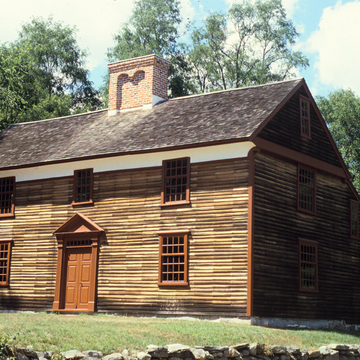Established in 1959 “to consolidate, preserve, selectively restore and interpret the Lexington–Concord Battle Road,” Minute Man National Historical Park attempts to reestablish the physical environment of 1775. The most intact section of this historical recreation lies along Virginia Road in Lincoln, north of Route 2A near its intersection with Bedford Road. Starting at the visitors' center near the Lexington end of Battle Road, one can walk along the dirt surface of Virginia Road to experience the conditions of the battle route to Concord. Periodic signs interpret the actions on that day in a landscape framed by cleared fields and occasional buildings. Near the intersection with Bedford Road stands the William Smith House (c. 1692, NHL/NRD), the home of the captain of the Lincoln Minutemen, rare for the cove cornice between the first and second floors. Farther north, the National Park Service has restored Ephraim Hartwell Tavern (NHL/NRD), begun around 1733, where costumed guides interpret the house furnished with replica items. Other park service buildings along Battle Road are not open to the public.
You are here
Minute Man National Historical Park, Battle Road
If SAH Archipedia has been useful to you, please consider supporting it.
SAH Archipedia tells the story of the United States through its buildings, landscapes, and cities. This freely available resource empowers the public with authoritative knowledge that deepens their understanding and appreciation of the built environment. But the Society of Architectural Historians, which created SAH Archipedia with University of Virginia Press, needs your support to maintain the high-caliber research, writing, photography, cartography, editing, design, and programming that make SAH Archipedia a trusted online resource available to all who value the history of place, heritage tourism, and learning.















